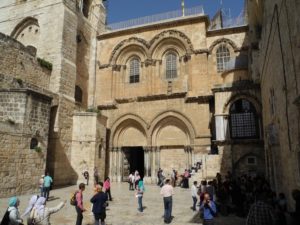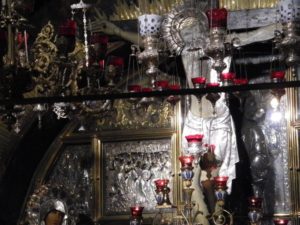
Some dear old friends of ours have recently gifted us with tickets to Israel – just now, in the first days of Lent. I can hardly believe the generosity! We returned from our pilgrimage a few days ago. Let me share with you a few reflections.
On our first day in the Old City of Jerusalem, Cindy and I visited the Church of the Holy Sepulchre. Maybe some of you have had the privilege, too. We thought to begin there, at the site proposed for Golgotha and the borrowed tomb, upon the recommendation of none other than Mark Twain. “One naturally goes first to the Holy Sepulchre,” he famously advised in a memoir of his travels.
This mighty cathedral is ancient, that is sure. Here, we are told, we find the very rock of Golgotha and the tomb in which our Lord once laid. Writing in the first years of the fourth century, Eusebius claimed that the site had been venerated and recognized as legitimate since the days of the apostles themselves. Constantine built a church upon the site in 325. During the period of construction, Helena is said to have found the remains of the cross itself.
I was impressed by the layers of accretion that have accumulated through the years: layers upon layers, in loud and gaudy array. There were stone layers laid down through centuries of building and rebuilding, from Constantine’s day, to Byzantine times, through the Crusader period, and to modern times. There were layers of silver and gold, candelabra and censer, kneeling rails, altar spaces, main chapels, side chapels, tapestries, plaques and engravings. There were layers of footprints throughout the place: millions upon millions of visitors have worn the floor smooth. There was iron scaffolding to hold up failing stone, plywood barriers to conceal (I suppose) ongoing renovation, boxes for offerings, receptacles for votive candles, and rope lines to shepherd the immense crowd of visitors that press in day by day. There were layers of worship, too: praying, kneeling, anointing, chanting, and here and there quiet meditation. There were Catholics and Coptics, Orthodox and Syriacs, Armenians, Ethiopians, and many more. Protestants seem to have added the largest accretion of all – an entire alternative site for Golgotha and the tomb, not far from the Damascus gate, outside the walls of the Old City.

There you will find additional layers of gift shops and chapels, long lines, narrow spaces, books, guides, pathways, interpretive inscriptions, and so on. (But not as much incense.)
In all the confusing flood of images, smells and sensations – one engraving leapt out at me, in particular. It wasn’t chiseled in stone; it was engraved in magic marker. It wasn’t a thousand years old; it could have been written last week. A pilgrim named Arturo left the little artifact, on a stone in the floor just opposite the bathrooms and a few paces from Golgotha. He drew a heart on the surface of the stone. Inside he scribed, “Arturo loves Jesus.” Here, it seemed to me at last, I could identify.
Our missionary trajectory through the centuries accumulates accretions of one variety or another, almost irrepressibly. We add (unwittingly, for the most part) cultural accretions, denominational accretions, layers upon layers that were not perhaps inherent to the first century church. We add worship styles, preferred worship languages, confessions, institutes, regulations and constitutions. Yet I wonder how much our many accretions lead us in the end to Jesus.
But Jesus is precisely the point.
There are so many very sophisticated ways to think about Lent and Holy Week. So many theories and theologies regarding what, precisely, happened at Golgotha and how, precisely, to get in on it. There are so many competing layers. They may become a blur for us.
But the core of Lent and Holy Week is really very simple: Arturo seemed to capture it. One can have all the sophisticated accretions in the world down pat and understood – all the philosophies, theologies, histories and archaeologies planted in one’s head – but if this simple core is absent in one’s heart, well, the whole lot gains us nothing.
God loves you. Enough to give his Son for you. Enough to raise him from the dead – “so that everyone who believes in him may not perish but may have eternal life.” (John 3:16).
I am not sure, frankly, that I will remember forever the dates of construction at the Holy Sepulchre, or its principal architects through the ages. But I will remember Arturo. Faith must be simple, I think, if it is to be deep. This Lent and Holy Week, remember to keep things simple, as Arturo seemed to do. The world doesn’t need our sophisticated theology, after all. The world needs Jesus.